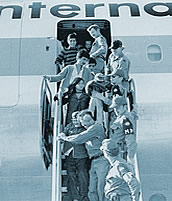Continued from page 2
Protest and Withdrawal
Meanwhile, as the number of U.S. casualties and costs increased, and anti-war protests in the United States grew, the U.S. government was forced to cease its involvement in the region. In 1973 the Paris Peace Accord/Agreement was signed, leading to the withdrawal of U.S. combat troops from the region. This was known as the “Vietnamization” operation, leaving the fighting to the South Vietnamese military.
The North Vietnamese communist forces overtook Saigon, the capitol of South Vietnam, on April 30, 1975, ending the Vietnam War. Two weeks earlier, on April 17 th, communist Khmer Rouge guerrillas had captured Phnom Penh, the capital of Cambodia. In May the Royal Lao Government of Laos gave way to communist forces, the Pathet Lao.
Phnom Penh, the capitol of Cambodia, was overtaken in April 17, 1975 by Khmer Rouge Communist forces and on April 30, 1975, North Vietnamese Communists took over Saigon, the capital of South Vietnam, ending the Vietnam War.
A Devastating Legacy
During the many years of foreign intervention and war in the region, millions of civilians became refugees in their own countries. Internal displacement was a strategic policy used by the U.S. government to control civilian populations and to prevent their recruitment by communist forces. In nine years the U.S. military had dropped more bombs on Southeast Asia than during all the previous world wars combined, destroying agricultural and forest lands and poisoning water systems in addition to leaving unknown numbers of land mines that continue to inflict injuries today.
Approximately 2.7 million Americans served in Vietnam. About 58,000 U.S. military personnel were killed and more than 150,000 injured. During the war and in its political aftermath, millions of Cambodians, Laotians, and Vietnamese were killed, an estimated 10 percent of the population, with millions more injured and homeless in each country.
The Aftermath
Most Americans think of the Vietnam War as the defining moment in the history of Southeast Asia. We often hear accounts of the Vietnam War from the U.S. perspective, particularly with regard to political and military decisions, rather than from the perspective of the populations in whose land the war was actually fought. For Southeast Asian Americans, however, this is only part of their history, since they came from cultures with thousands of years of civilization before the war.
The displacement that occurred in the aftermath of the war forced many to leave their homelands, find new forms of employment, learn a new language, and adapt to new customs – essentially, to begin new lives. In the process, they are reshaping the United States. Understanding the experiences of Southeast Asian Americans helps to clarify the impact of U.S. foreign policy strategies and diplomacy, American procedures regarding refugees and immigrants, and what it means to be an ethnically and racially diverse nation. 

|

